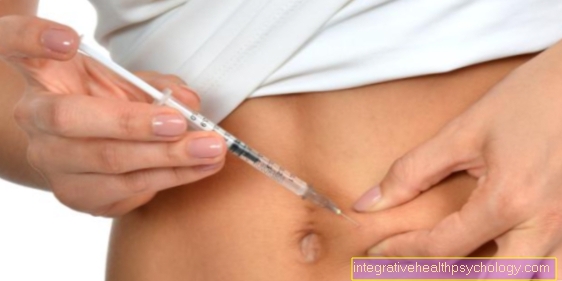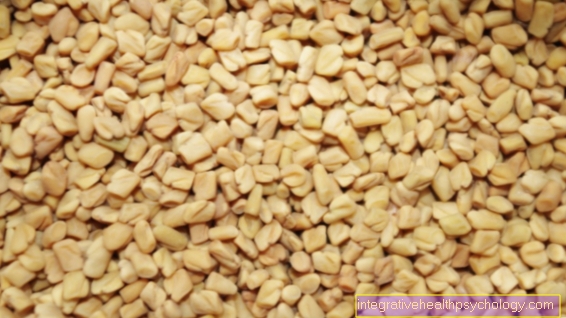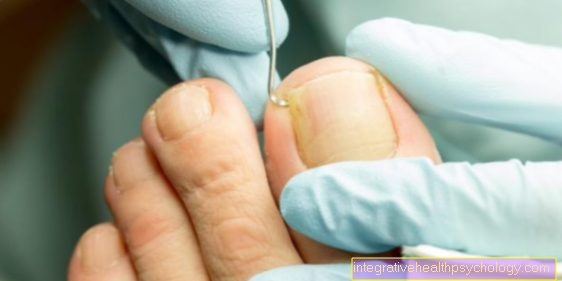Nasal septum OP
introduction
The nasal septum is called in technical jargon Nasal septum designated.
It consists of an anterior, cartilaginous and a posterior, bony part. The nasal cavity is divided into two main nasal cavities by the nasal septum. Normally, when you breathe, air flows in and out of both cavities. If the nasal septum deviates from the central position, the normal flow of breath through the nose may be disturbed.
A curvature of the nasal septum is also called a septal deviation. This can be the result of congenital changes in shape or external influences such as injuries.
Since the cartilaginous and bony parts of the nasal septum grow at different speeds, very few people have the nasal septum exactly in the middle. Small deviations are normal and do not cause any impairment. However, if the curvature is more pronounced, this can affect nasal breathing.
In addition, the ability to smell can be reduced. The restricted ventilation can lead to increased inflammation of the main nose and sinuses. This can often be accompanied by recurring headaches. In some cases, patients complain of frequent nosebleeds.
A nasal passage can be blocked on one side and may require treatment. In rare cases, the nasal septum can also be s-shaped and cause blocked nasal breathing on both sides. The treatment of choice is surgery, nasal septum surgery.
Read more on the topic: Curvature of the septum

Indication for nasal septum surgery
Surgical correction only makes sense if the "deformed" nasal septum causes discomfort and restrictions.
This means that if the patient permanently suffers from restricted nasal breathing, headaches and / or sleep disorders, a nasal septum operation should be considered.
This can be the case with a more pronounced curvature of the nasal septum, with permanent swelling of the nasal mucous membrane or with a bruise, abscess or hole in the septum.
Procedure of the operation
For a curvature of the nasal septum that requires therapy, a so-called seroplasty is the treatment of choice.
Before the operation, there is a consultation and information meeting with the doctor and the anesthetist. It is also important to inform the attending physician about medication and previous illnesses. Drugs that reduce blood clotting may need to be exposed.
In some cases, the operation is performed under local anesthesia. In other cases, general anesthesia is recommended. According to the anesthetic measure, a period of time with regard to the ban on eating, drinking and smoking is specified before the operation.
The operation itself starts with an incision in the anterior area of the nasal septum. The nasal mucosa is then detached from the septum. Then the bent parts are removed. Outside the nose, these are then straightened and reinserted.
If a permanently enlarged nasal mucous membrane also leads to impairment, it is reduced with the help of electricity or a laser. Parts of the nasal mucosa or turbinate may also be relocated or removed. If there is a bruise of the septum, a so-called Nasal septum hematoma, a drain is placed and the nasal septum is splinted.
If there is a hole in the nasal septum, the hole is surgically closed with a mucosal flap. The operation can be performed on an outpatient or inpatient basis. The medication can continue to work for up to 24 hours. Therefore, the patient should not drive or use machines after the operation. If the operation took place on an outpatient basis, the patient should be picked up. In addition, you should avoid making important decisions on the same day.
To avoid injury, the patient should gently dab nasal secretions instead of blowing their nose for several days. Sneezing should be done with your mouth open for the first few days after surgery.
Pain in a nasal septum surgery
The nasal septum operation is usually not painful due to the anesthetic effect. If pain occurs during the operation, the anesthetist can react immediately. Questions about anesthesia and the development of pain can be clarified in a preliminary talk. Since everyone perceives pain differently and reacts differently to different pain relievers, it can also be helpful to share them in advance.
As a rule, however, there is little or no pain even after the nasal septum operation. If acute pain occurs, it is possible to use painkillers individually at any time. In most cases, however, this is not necessary. Instead of pain, some patients report swelling and tightness in the skin of the nose.
In particular, in the first few nights and when removing the tamponade and / or splint, there may be short-term disorders.
Risks of the nasal septum surgery
As a rule, an operation on the nasal septum is low-risk.
However, every operation carries certain risks, including the nasal septum operation. Allergic reactions can occur. Structures near the nasal septum can be injured.
Bleeding, secondary bleeding, bruising, swelling and possibly pain can occur. In addition, especially with a weakened immune system, inflammation, wound healing problems and scars can occur.
In rare, unfavorable cases, the nose may be deformed after the operation. In addition, a hole in the nasal septum may appear or an existing hole may enlarge. Adhesions of the nasal mucous membrane are also possible, and an opening between the nasal and oral cavities remains.
In rare exceptional cases, the skull bone can be injured. In this case, brain fluid could leak and meningitis could develop. However, this happens very rarely. In a few cases, the nasal septum correction leads to permanent restriction of nasal breathing and odor.
In unfavorable cases, the nasal mucous membrane can dry out after the operation and a so-called smelly nose can develop. This means that an unpleasant smell is constantly emerging from the nose. In rare exceptional cases, structures of the eye can be damaged. In these cases, visual disturbances or blindness can occur. However, this happens very rarely.
If complications arise, the surgeon can, in most cases, intervene early. After the operation, around a third show anesthetic aftereffects such as nausea or, more rarely, vomiting. These can be uncomfortable. However, they are usually harmless and subside after a few hours.
Read more on the subject below: Surgery of a curvature of the nasal sheath wall
Duration of the nasal septum surgery
A nasal septum surgery usually takes between 30-50 minutes. If other additional measures are taken in addition to correcting the nasal septum, the operating time will be extended accordingly.
Duration of healing after a nasal septum operation
As a rule, the nose's healing process starts after a few days. Patients often report that the nose becomes clearer every day and that it is easier to breathe. As a result, sleep becomes better and more comfortable. After a few days, the sense of smell returns completely.
In most cases, the nose has completely recovered within 2-3 weeks. In the case of inpatient surgery, the hospital stay usually lasts between 3-7 days.
Duration of sick leave for a nasal septum operation
The patient is usually on sick leave for two weeks. Depending on the field of activity and the healing process, the sick leave can be extended by a further week. For example, if work is accompanied by heavy physical strain, an extension of the sick leave may be justified.
Tamponade at the nasal septum OP
In many cases, a nasal packing is inserted into the nose after the operation.
Its purpose is to catch bleeding and prevent adhesions between the septum and nasal concha. Since the septum is still unstable after the operation, it should support it. It varies as to how comfortable or uncomfortable it is to wear the tamponade. In some cases, the tamponade can cause pressure pain in the nose and head area, as well as irritation of the throat.
The tamponade can disturb the patient at night and possibly prevent them from sleeping. The tamponade is usually removed after 48 hours. This can also be uncomfortable in the short term. Exhaling while pulling the tamponade appears to be more comfortable.
Nasal septum OP without tamponade
In some cases, a tamponade is dispensed with. Due to the patient's discomfort when wearing a tamponade, silicone films are increasingly being used instead. There are various scientific studies showing that alternatives to tamponade can achieve the same goals with fewer disadvantages. Further studies are planned. The avoidance of tamponades after the nasal septum operation is a controversial issue.
Follow-up treatment for nasal septum surgery
After the nasal septum surgery, comprehensive care of the nose is very important.
The measures are shown to the patient. This person must then conscientiously carry out the care measures and instructions at home on their own responsibility. To prevent bacterial pathogens from settling in the nose, the nose must be rinsed at least 3 times a day.
After that, the nose should always be gently rubbed with a nasal ointment recommended by the doctor. These measures serve to prevent crust formation and promote the healing process. A nasal spray can be used to keep the nasal mucosa moist. However, the spray should be used sparingly and only for a short time.
The other maintenance measures should be carried out for at least 2 weeks. The rinses can then be slowly reduced. If in doubt, the attending physician should be asked. In addition, it is important that the patient avoid anything that increases the blood pressure in the head area for the first 2 weeks after the operation.
For example, hot showers or hot baths should be avoided. Frequent stooping or lifting heavy loads should be avoided. The patient should stay away from sunbathing, sauna facilities, strong coffee and alcohol consumption for at least the first 2 weeks postoperatively. Beats, bumps or pressure on the nose should be avoided. You shouldn't wear glasses at first either. Contact lenses, on the other hand, can normally be worn straight away.
When can you start doing sports again after a nasal septum operation?
Physical strain and exertion must be strictly avoided in the first 2-3 weeks. Accordingly, the patient should also take a break from any sport for 2-3 weeks. Since exercise can also lead to an increase in blood pressure in the head, it can affect the healing process of the nose.
If you start exercising again too early, not only can the success of the operation be destroyed, but there is also a risk of complications. In the first few days in particular, it is very important to be as physically as possible. Later, regular movement, in the sense of going for a walk without exertion, is allowed, as long as it is good for the patient. However, it is important to refrain from all sporting activities for at least 2-3 weeks. To avoid complications, the patient should strictly follow the instructions. Before starting sports again, a doctor should be consulted. If uncertainties or complications arise beforehand, the doctor should be informed and consulted directly.
Splints after a nasal septum operation
It is also possible to stabilize the septum after the operation with a splint made of silicone foil for 1-2 weeks instead of with a tamponade.
These splints are fixed in the nose with a small seam. The modern silicone splints have breathing tubes. A minimal amount of air can enter the nose through this. In the first few hours after the operation, however, the patient has to breathe through the mouth.
Dry mouth can develop, which can be alleviated by regularly moistening the mouth. The silicone splints are usually removed after 5-10 days.





























